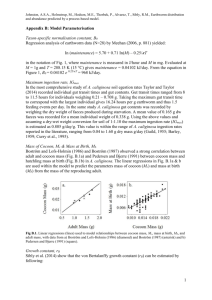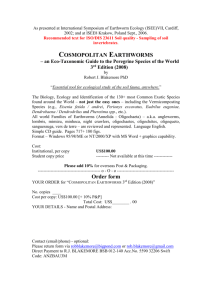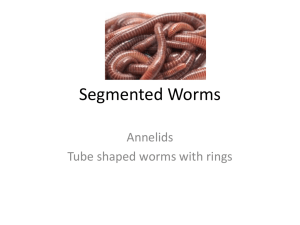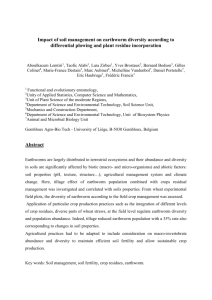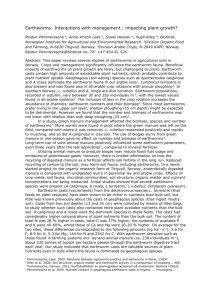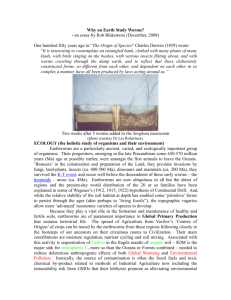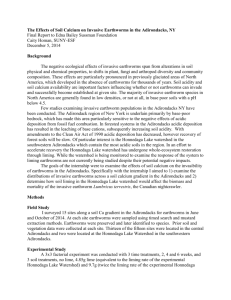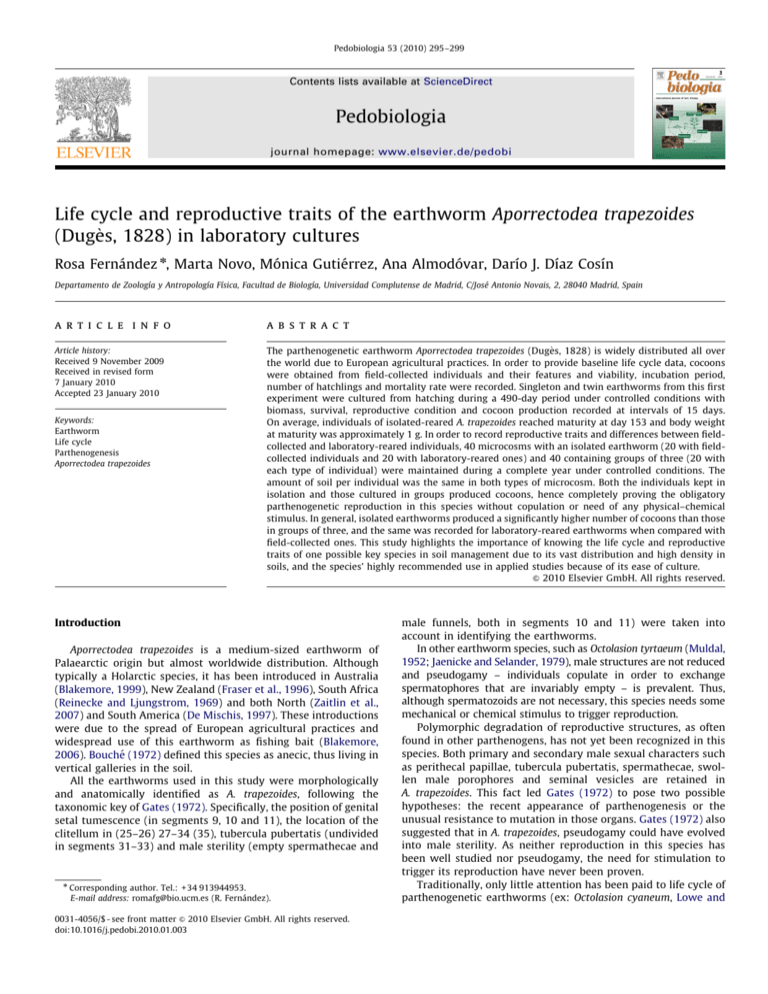
ARTICLE IN PRESS
Pedobiologia 53 (2010) 295–299
Contents lists available at ScienceDirect
Pedobiologia
journal homepage: www.elsevier.de/pedobi
Life cycle and reproductive traits of the earthworm Aporrectodea trapezoides
(Duge s, 1828) in laboratory cultures
Rosa Fernández n, Marta Novo, Mónica Gutiérrez, Ana Almodóvar, Darı́o J. Dı́az Cosı́n
Departamento de Zoologı́a y Antropologı́a Fı́sica, Facultad de Biologı́a, Universidad Complutense de Madrid, C/José Antonio Novais, 2, 28040 Madrid, Spain
a r t i c l e in fo
abstract
Article history:
Received 9 November 2009
Received in revised form
7 January 2010
Accepted 23 January 2010
The parthenogenetic earthworm Aporrectodea trapezoides (Duge s, 1828) is widely distributed all over
the world due to European agricultural practices. In order to provide baseline life cycle data, cocoons
were obtained from field-collected individuals and their features and viability, incubation period,
number of hatchlings and mortality rate were recorded. Singleton and twin earthworms from this first
experiment were cultured from hatching during a 490-day period under controlled conditions with
biomass, survival, reproductive condition and cocoon production recorded at intervals of 15 days.
On average, individuals of isolated-reared A. trapezoides reached maturity at day 153 and body weight
at maturity was approximately 1 g. In order to record reproductive traits and differences between fieldcollected and laboratory-reared individuals, 40 microcosms with an isolated earthworm (20 with fieldcollected individuals and 20 with laboratory-reared ones) and 40 containing groups of three (20 with
each type of individual) were maintained during a complete year under controlled conditions. The
amount of soil per individual was the same in both types of microcosm. Both the individuals kept in
isolation and those cultured in groups produced cocoons, hence completely proving the obligatory
parthenogenetic reproduction in this species without copulation or need of any physical–chemical
stimulus. In general, isolated earthworms produced a significantly higher number of cocoons than those
in groups of three, and the same was recorded for laboratory-reared earthworms when compared with
field-collected ones. This study highlights the importance of knowing the life cycle and reproductive
traits of one possible key species in soil management due to its vast distribution and high density in
soils, and the species’ highly recommended use in applied studies because of its ease of culture.
& 2010 Elsevier GmbH. All rights reserved.
Keywords:
Earthworm
Life cycle
Parthenogenesis
Aporrectodea trapezoides
Introduction
Aporrectodea trapezoides is a medium-sized earthworm of
Palaearctic origin but almost worldwide distribution. Although
typically a Holarctic species, it has been introduced in Australia
(Blakemore, 1999), New Zealand (Fraser et al., 1996), South Africa
(Reinecke and Ljungstrom, 1969) and both North (Zaitlin et al.,
2007) and South America (De Mischis, 1997). These introductions
were due to the spread of European agricultural practices and
widespread use of this earthworm as fishing bait (Blakemore,
2006). Bouché (1972) defined this species as anecic, thus living in
vertical galleries in the soil.
All the earthworms used in this study were morphologically
and anatomically identified as A. trapezoides, following the
taxonomic key of Gates (1972). Specifically, the position of genital
setal tumescence (in segments 9, 10 and 11), the location of the
clitellum in (25–26) 27–34 (35), tubercula pubertatis (undivided
in segments 31–33) and male sterility (empty spermathecae and
n
Corresponding author. Tel.: + 34 913944953.
E-mail address: romafg@bio.ucm.es (R. Fernández).
0031-4056/$ - see front matter & 2010 Elsevier GmbH. All rights reserved.
doi:10.1016/j.pedobi.2010.01.003
male funnels, both in segments 10 and 11) were taken into
account in identifying the earthworms.
In other earthworm species, such as Octolasion tyrtaeum (Muldal,
1952; Jaenicke and Selander, 1979), male structures are not reduced
and pseudogamy – individuals copulate in order to exchange
spermatophores that are invariably empty – is prevalent. Thus,
although spermatozoids are not necessary, this species needs some
mechanical or chemical stimulus to trigger reproduction.
Polymorphic degradation of reproductive structures, as often
found in other parthenogens, has not yet been recognized in this
species. Both primary and secondary male sexual characters such
as perithecal papillae, tubercula pubertatis, spermathecae, swollen male porophores and seminal vesicles are retained in
A. trapezoides. This fact led Gates (1972) to pose two possible
hypotheses: the recent appearance of parthenogenesis or the
unusual resistance to mutation in those organs. Gates (1972) also
suggested that in A. trapezoides, pseudogamy could have evolved
into male sterility. As neither reproduction in this species has
been well studied nor pseudogamy, the need for stimulation to
trigger its reproduction have never been proven.
Traditionally, only little attention has been paid to life cycle of
parthenogenetic earthworms (ex: Octolasion cyaneum, Lowe and
ARTICLE IN PRESS
296
R. Fernández et al. / Pedobiologia 53 (2010) 295–299
Butt, 2008; Perionyx ceylanensis, Karmegan and Daniel, 2009).
Nevertheless, earthworm species with this kind of reproduction
could be potentially more appropriate than hermaphroditic ones
in applied studies. As suggested by Lowe and Butt (2007),
obligatory parthenogenetic species should be preferrable to
amphimictic species as ecotoxicological test organisms due to
their low genetic heterogeneity. Also, these earthworms can
be maintained in isolation, allowing for individually monitored
endpoints. Experiments on life cycles have usually been done only
with field-collected individuals or with laboratory-reared ones.
Hence, some aspects have been poorly tested, such as the
existence of putative learning processes in the field, and
differences between potential and real growth and reproduction.
Interest in A. trapezoides has been strongly biased towards its
role in soils. Some ecological aspects, such as its distribution as an
exotic species and its effect on soil properties, crops or farming
systems, have been considered very important. Nevertheless, its
life cycle has only been studied under field conditions (population
dynamics and changes in abundance) and during short periods of
time (19 weeks; McCredie et al., 1992). Thus, little is known about
the life cycle of one of the most abundant earthworm species
distributed worldwide. This fact hinders the development of
appropriate management strategies to optimise its role in
maintaining soil properties and in assessing its potential effects
on natural and agricultural ecosystems in relation to its possible
use in applied studies of ecotoxicology, vermicomposting or
ecological restoration.
Therefore, the aims of this study were to obtain baseline data
on: (1) cocoon and hatchling production, morphological features
and viability; (2) growth rates under optimal laboratory conditions; (3) possible requirements to trigger reproduction; and (4)
differences in reproduction between field-collected individuals
and laboratory-reared ones.
Materials and methods
Cocoon features and number of hatchlings from field-collected
individuals
Mature individuals of A. trapezoides were obtained by digging
and hand sorting of soil from a grassland in El Molar (Madrid, Spain,
401 440 22.9 N; 0031 330 53.1 W). Earthworms were kept in two
plastic vessels (between 15 and 25 per vessel, surface area 0.19 m2,
depth 10 cm) with sealable lids pierced with a needle to allow
ventilation. These microcosms were filled with 2 kg of fieldcollected soil previously dried and sieved (2 mm). The earthworms
were fed dried cow manure that was added to the soil surface (1% of
soil weight) and they were kept in a scientific incubator at 16 1C in
24 hours darkness. Soil moisture was maintained at 25% (previously
stated to be in the optimal range of moisture percentage for several
lumbricid species; Lowe and Butt, 1999). Cocoons (n=244) were
hand-sorted every 15 days from these stocks, their size and weight
were recorded, and 147 of them were incubated in separately
labelled Petri dishes on filter paper (Whatman No. 1) with excess
water to avoid desiccation. A total of 241 hatchlings were obtained.
Dishes were inspected daily in order to record viability and number
of hatchlings per cocoon. Length of incubation was calculated as the
time to hatch after collection plus 7 days (half of the time between
sampling periods).
Growth of laboratory-reared individuals
Thirty-seven of the 241 hatchlings (24 singletons and 13 twin
individuals) were maintained individually in 250 ml plastic
vessels (surface area 0.025 m2, depth 5.5 cm) with 250 g of dried
and sieved soil (2 mm), fed with dried cow manure (1% of soil
weight), with 25% moisture and maintained at 16 1C. Individual
earthworm survival, biomass and reproductive condition were
recorded every 15 days for a 490-day period. Vessel contents were
replaced at each sampling. When the individuals reached
maturity (defined by the presence of a swollen clitellum), cocoons
were collected by wet-sieving the soil (2 mm). A two-sample
Student’s t-test was employed to analyse differences in weight
and total cocoon production between singletons and twins. An
alpha level of Pr 0.05 was considered statistically significant. All
analyses were completed using the software Statistica version 6.0.
Data are presented as means7S.D.
As a complementary growth measure, instantaneous growth
rates (IGRs) were calculated for each 15-day growth interval. IGRs
assume that growth proceeds logistically rather than linearly
(Eriksen-Hamel and Whalen, 2006). Their values are obtained by
calculating the change in an individual’s growth during an
infinitely short time interval (Pertrusewicz and Macfayden,
1970). The IGR was calculated using the equation:
IGR ¼ lnðWf =Wi Þ=Dt
where Wi and Wf are initial and final earthworm mass (g),
respectively, and Dt is the growth interval measured in days
(Brafield and Llewellyn, 1982).
Detecting possible requirements to trigger parthenogenetic
reproduction
Mature individuals (n = 40) collected during different seasons
of the year (autumn, winter and spring) in El Molar were studied
anatomically to check for the absence of sperm in the spermathecae. These organs were removed, placed on a slide, squashed
under a cover slip, and viewed under a light microscope (400X).
Once male sterility was checked in this population, 80 mature
individuals were field-collected to prepare the experiment.
Twenty of these were kept individually in 250 ml plastic vessels
(labelled as If). Sixty individuals were maintained in groups of
three in 750 ml plastic vessels (labelled as Gf; surface 0.041 m2,
depth 12.5 cm). The contents and conditions of each microcosm
were the same as in experiment 2 (see above), except with three
times more soil in the second type of microcosm to maintain a
constant quantity per earthworm. Every 15 days, vessel contents
were replaced. The discarded soil was wet-sieved in order to
collect cocoons. This experiment was maintained over an entire
year. The same procedures were undertaken with laboratoryreared individuals, with the microcosms containing one individual labelled Il and those with three earthworms, Gl.
Repeated measures analyses of variance (RM-ANOVA), followed
by post-hoc paired comparison t-tests (when appropriate) were
employed to test for significant differences. Mauchley’s test was
conducted to examine sphericity for the repeated measures analyses.
If the assumption of sphericity was violated, the Greenhouse-Geisser
adjustment was used to protect against type I error (Keselman et al.,
2001). In every case, the significance level was set at 5%.
Results
Cocoon features and number of hatchlings from field-collected
individuals
A. trapezoides produced between 1 and 4 hatchlings per
cocoon, with 87% of 244 collected cocoons hatching successfully.
Of these, 59% yielded singletons and 38% twins. Remarkably,
3 cocoons produced triplets (2%) and 2 produced quadruplets
ARTICLE IN PRESS
R. Fernández et al. / Pedobiologia 53 (2010) 295–299
(1%). The mean biomass was 0.01470.006 g, ranging from
0.0011 g (in quadruplets) to 0.0327 g (in singletons) (n = 241).
The mean obtained from this data was 1.6770.59 hatchlings per
cocoon. In 2% of the cocoons, conjoined twin individuals (at head
or tail) were recorded. During the first two weeks, 4.9% of twins
and 1.69% of singletons died. One month after hatching, hatchling
survival was 94.6%. Cocoons were characterised by a mean mass
of 0.033 70.008 g and a size of 5.770.8 mm (length) and
3.370.4 mm (width). Incubation time of these cocoons was
41.9 79.6 days under culture conditions.
Growth of laboratory-reared individuals
After the 490-day experimental period, 100% survival of
laboratory-reared individuals was recorded. The growth of
A. trapezoides followed a sigmoid curve (Fig. 1), with a slow initial
phase over 60 days (mean weight of 0.10170.026 g), an exponential
phase over 285 days (mean weight of 2.74570.566 g), and a
stationary growth phase reached after 345 days, with a mean weight
of 3.30770.695 g. The length of growth phases was determined by
calculating the points where both the lower and upper asymptotes
cross the tangent line to the inflexion point. Sexual maturity
was reached between days 142 and 165 both for singletons and
twins, with a mean weight of 1.00570.172 g. Cocoon production
297
was recorded as soon as maturity was reached, and the mean
reproduction rate was 4.0671.26 cocoons per earthworm per two
weeks (that is, approximately 105 cocoons per earthworm per year).
Upon sampling, two of the individuals were found to be sporadically
inactive and coiled in spherical chambers.
Significant differences between individual mean mass of
singletons and twins were only recorded at days 1 and 15, with
singletons having greater biomass (Student’s t-test; t = 3.48;
df= 36, Po0.01; t =3.51, df= 36, Po0.01, respectively). No significant differences were observed in mean weight between either
type of individuals during the remainder of the experiment
(Student’s t-test; t = 0.23, df = 64, P= 0.82), or in their mean
reproductive rate (Student’s t-test; t =1.01, df= 36, P= 0.317).
IGR values followed a logarithmic pattern, with the same
phases observed as in the previous growth pattern (Fig. 2). During
the exponential phase, IGR reached its lowest value at day 150,
the same period when individuals reached sexual maturity. After
day 330, IGR values were close to zero.
Detecting possible requirements to trigger parthenogenetic
reproduction
All individuals of A. trapezoides kept in isolation (from both
origins) produced cocoons throughout the experiment. All
Fig. 1. Growth pattern in Aporrectodea trapezoides at 16 1C (means7 SE, n= 37). Initial, exponential and stationary phases of growth are noted.
Fig. 2. Instantaneous Growth Rate values in Aporrectodea trapezoides at 16 1C (n=37). The trend line is showed as a dash line. Initial, exponential and stationary phases are noted.
ARTICLE IN PRESS
298
R. Fernández et al. / Pedobiologia 53 (2010) 295–299
Table 1
Significance of differences in the mean rate of cocoon production compared among
the different types of microcosms.
Microcosms compared
F- and P-value
Significance of
differences
If vs Gf
Il vs Gl
Il vs If
Gl vs Gf
(If + Il) vs (Gf + Gl)
(If + Gf) vs (Il + Gl)
F(1,19) = 18.23; P = 0.183
F(1,19) = 23.03; P o0.001
F(1,19) = 54.96; P o0.001
F(1,19) = 34.42; P o0.001
F(1,19) = 6.99; P o0.001
F(1,19) = 18.88; P o0.001
n.s.
n
(4
n
(4
n
(4
n
(4
n
(4
in
in
in
in
in
Il)
Il)
Gl)
If + Il)
Il + Gl)
n.s. indicates no significant differences while n indicates significant differences. In
brackets, the microcosm type in which the highest cocoon production was
recorded for each comparison is noted.
individuals collected in the field during every season of the year
were dissected to check male sterility, hence pseudogamy was
ruled out and parthenogenetic reproduction was proven in this
population. Nevertheless, cocoon production was different in the
four types of microcosms, as detailed below.
The mean rate of cocoon production per earthworm per 15
days was compared among the different microcosms (If, Gf, Il and
Gl). Mean cocoon production throughout the year in each kind of
microcosm was 1.60 70.83 cocoons per earthworm per 15 days in
If, 1.31 70.47 in Gf, 4.16 71.49 in Il and 2.44 71.71 in Gl.
Repeated measures one-way ANOVA showed no significant
differences in rates between If and Gf microcosms, but cocoon
production rates were significantly higher in earthworms from Il
microcosms than those from Gl ones, in individuals from Il
microcosms compared to those from If ones, and in specimens
from Gl microcosms compared to those from Gf ones. Isolated
earthworms (If and Il) showed significantly higher rates than
those cultured in groups of three (Gf and Gl), as did laboratoryreared individuals (Il and Gl) when compared with field-collected
earthworms (If and Gf) (Table 1).
Aestivation was observed in a variable percentage of fieldcollected individuals during the experiment in both types of
microcosm (If and Gf), generally after the summer period. The
percentage of individuals in aestivation varied between 5% and
25% of the total clitellate individuals in each type of microcosm.
As this percentage was similar in both types of microcosm, mean
rate of cocoon production in aestivation periods was compared,
but showed no significant differences (F(1,19) =1.46, P =0.239). This
process was only observed once in two laboratory-reared
individuals.
Discussion
A. trapezoides seems to be a suitable species for laboratory
culture with its high percentage of adult and hatchling survival,
and high cocoon viability. Taking into account the fact that each
individual could potentially produce more than 150 live hatchlings per year, this species is appropriate for laboratory experiments. Thus, the use of this species is highly recommended in
applied studies, such as ecological restoration of roadside slopes
(Trigo, D., unpublished data), biological agriculture or ecotoxicological tests, as suggested by Lowe and Butt (2007) for
parthenogenetic earthworms.
The rates of cocoon production and the number of hatchlings
per cocoon vary enormously among earthworm species. The rate
recorded in this study for A. trapezoides (105 cocoons per
earthworm per year) is higher than the rate recorded in other
anecic or endogeic species, such as Octodrilus complanatus
(52 cocoons per earthworm per year; Monroy et al., 2007), or
Lumbricus terrestris (38 cocoons per earthworm per year; Butt,
1993). This rate places this species closer to epigeic species such
as Eisenia fetida (70 cocoons during its 27 weeks of life;
Hartenstein et al., 1979).
The results of this laboratory study can be compared with
those of McCredie et al. (1992) who studied the population
dynamics of A. trapezoides under field conditions in Australia.
Several traits such as number of hatchlings per cocoon, incubation
time and weight after reaching maturity were similar in both
studies. Due to the short experimental time in the McCredie et al.
field experiment, nothing was revealed about the other traits
investigated in the present study, which provide additional
information for a complete picture of the life cycle of this
important species. Although results are quite similar under both
field and laboratory conditions, more data about the life cycle of
this species in the field will be useful for comparisons of other life
traits, such as cocoon viability, length of life or cocoon production.
In contrast to the results obtained by Lowe and Butt (2008) for
Octolasion cyaneum, growth rates and fecundity of A. trapezoides
were not influenced by the individual status of singletons or
twins, although hatchling singletons had a mean weight almost
twice that of twins. After the first 15 days, weight was not
significantly different between both types of individuals, but
mortality rates were higher in twins during this initial period.
Lowe and Butt (2008) suggested that twins are likely to survive
under adverse environmental conditions. The addition of twins
would provide an advantageous increase in the population during
the colonisation of new areas, when the number of individuals
would outweigh the advantage of individual size. In A. trapezoides
however, things seem to be different: twin/singleton status does
not have an influence on individual size, but does influence
mortality rate during the first 15 days of laboratory life. Thus, a
trade-off seems to exist between the number of hatchlings per
cocoon and mortality rates during the first days.
For field-collected individuals, mean rates of cocoon production were statistically similar to isolated earthworms and to those
cultured in groups of three. Thus, the presence of other
individuals in the same microcosms has neither a positive (for
example, enhancing reproduction) nor a negative effect on this
rate. Nevertheless, it is higher in laboratory-reared isolated
individuals than those in groups of three. Density of earthworms
influences growth, weight and fecundity of adults. For example,
reproductive capacity of L. terrestris was reduced when cultured at
high densities (15–25 g of earthworms per 2 l of soil; Lowe and
Butt, 2005). In this study, it is suggested that three earthworms
(a total weight of 4–6 g) could be considered a high density for
A. trapezoides, hence producing a negative effect on potential
cocoon production (which has only been recorded in laboratoryreared individuals) among individuals in the same microcosms. It
can be hypothesised that in microcosms with field-collected
individuals this physical disturbance was lower and had no
significant impact due to the periodical inactivity of the earthworms.
All individuals of A. trapezoides kept in isolation produced
viable cocoons during the whole experimental period, hence
completely ruling out both the existence of pseudogamy and the
necessity of physical–chemical stimulus to trigger reproduction in
this species. Cocoon production was higher in isolated earthworms (taking into account both field-collected and laboratoryreared ones) than in those cultured in groups of three. As some
field-collected individuals entered aestivation several times
during the experiment, full reproductive capacity was not shown.
In contrast, laboratory-reared earthworms showed their potential
capacity, as they rarely entered aestivation. It is worth mentioning
that cocoon production was recorded during the first year of life
in laboratory-reared individuals, but the age of field-collected
ARTICLE IN PRESS
R. Fernández et al. / Pedobiologia 53 (2010) 295–299
earthworms could not be determined. Reproduction has been
shown to be age-dependent in some invertebrates, but only a few
examples can be found in the literature (e.g., in the cercariae
Transversotrema patialense; Mills, 2002). It might be of interest
to test whether cocoon production varies with the age of
A. trapezoides.
In earthworms, both sexual and parthenogenetic reproduction
is observed, thus making this group suitable for studying models
of animal reproduction. Although there is much scientific
literature on the subject, no explanation has been universally
accepted about the origin and maintenance of sexual and asexual
reproduction. Asexual species have been traditionally considered
as ‘‘dead end streets’’ that would be unavoidably extinguished due
to their lower evolutionary capacity. Many questions still remain
open about the biology of A. trapezoides. For example, does this
species have a ‘‘general purpose genotype’’ (being able to adapt to
a wide range of habitats) or is there a high clonal diversity (each
clone being able to differentially adapt to a specific ecological
niche)? Did it originate by hybridization from closely related
species? Is its genetic diversity high or low? Despite these
evolutionary questions, its biological success is unquestionable.
Not only is A. trapezoides one of the most abundant earthworm
species, but it is also very successful under different environmental conditions. Thus, both its importance as a possible key
species in soil management and its highly recommended use in
applied studies must be highlighted.
Acknowledgements
We would like to thank Dolores Trigo and Juan B. Jesús for field
assistance, and two anonymous reviewers for their useful
comments on the manuscript. R. Fernández is currently supported
by a research grant from Complutense University of Madrid
(Spain). This study was funded by the Spanish Government.
References
Blakemore, R.J., 1999. The diversity of exotic earthworms in Australia – a status
report. In: Ponder, W., Lunney, D. (Eds.), The Other 99%. The Conservation and
Biodiversity of Invertebrates. Transactions of the Royal Zoological Society of
New South Wales, Mosman, Australia, pp. 182–187.
Blakemore, R.J., 2006. Cosmopolitan Earthworms – An Eco-Taxonomic Guide to the
Peregrine Species of the World, second ed. VermEcology, Japan.
299
Brafield, A.E., Llewellyn, M.J., 1982. Animal Energetics. Blackie and Son Ltd.,
Glasgow, UK.
Bouché, M.B., 1972. Lombriciens de France. Écologie et Systématique. INRA, Paris
671 pp.
Butt, K.R., 1993. Reproduction and growth of three deep-burrowing earthworms
(Lumbricidae) in laboratory culture in order to assess production for soil
restoration. Biol. Fert. Soils 16, 135–138.
De Mischis, C.C., 1997. Earthworms (Annelida, Oligochaeta) of a provincial
reserva in Córdoba, Argentina: a preliminary survey. Soil. Biol. Biochem. 29,
235–236.
Eriksen-Hamel, N.S., Whalen, J.K., 2006. Growth rates of Aporrectodea caliginosa
(Oligochaetae: Lumbricidae) as influenced by soil temperature and moisture in
disturbed and undisturbed soil columns. Pedobiologia 50, 207–215.
Fraser, P.M., Williams, P.H., Haynes, R.J., 1996. Earthworm species, population size
and biomass under different cropping systems across the Canterbury Plains,
New Zealand. Appl. Soil Ecol. 3, 49–57.
Gates, G.E., 1972. Contributions to North American earthworms (Annelida:
Oligochaeta). No. 3. Toward a revision of the earthworm family Lumbricidae.
IV. The trapezoides species group. Bull. Tall Timbers Res. Stn. 12, 1–146.
Hartenstein, R., Neuhauser, E.F., Kaplan, D.L., 1979. Reproductive potential of the
earthworm Eisenia foetida. Oecologia 43, 329–340.
Jaenicke, J., Selander, K., 1979. Evolution and ecology of parthenogenesis in
earthworms. Am. Zool. 19, 729–737.
Karmegan, N., Daniel, T., 2009. Growth, reproductive biology and life cycle of the
vermicomposting earthworm, Perionyx ceylanensis Mich. (Oligochaeta: Megascolecidae). Bioresource Technol. 100, 4790–4796.
Keselman, H.J., Algina, J., Kowalchuk, R.K., 2001. The analysis of repeated measures
designs: a review. Br. J. Math. Statist. Psychol. 54, 1–20.
Lowe, C.N., Butt, K.R., 1999. Interspecific interactions between earthworms:
potential applications in soil amelioration. Pedobiologia 43, 808–817.
Lowe, C.N., Butt, K.R., 2005. Culture techniques for soil dwelling earthworms: a
review. Pedobiologia 49, 401–413.
Lowe, C.N., Butt, K.R., 2007. Earthworm culture, maintenance and species selection
in chronic ecotoxicological studies: a critical review. Eur. J. Soil Biol. 43,
281–288.
Lowe, C.N., Butt, K.R., 2008. Life cycle traits of the parthenogenetic earthworm
Octolasion cyaneum (Savigny, 1826). Eur. J. Soil Biol. 44, 541–544.
McCredie, T.A., Parker, C.A., Abbott, I., 1992. Population dynamics of the
earthworm Aporrectodea trapezoides (Annelida: Lumbricidae) in a Western
Australian pasture soil. Biol. Fert. Soils 12, 285–289.
Mills, C.A., 2002. Age- and density-dependent growth within populations of the
ectoparasitic digenean Transversotrema patialense on the fish host. Int.
J. Parasitol. 10, 287–291.
Monroy, F., Aira, M., Gago, J.A., Domı́nguez, J., 2007. Life cycle of the earthworm
Octodrilus complanatus (Oligochaeta, Lumbricidae). C. R. Biologies 330,
389–391.
Muldal, S., 1952. The chromosomes of the earthworms. I. The evolution of
polyploidy. Heredity 6, 55–76.
Pertrusewicz, K., Macfayden, A., 1970. Productivity of Terrestrial Animals.
Principles and Methods. Blackwell, Oxford.
Reinecke, A.J., Ljungstrom, P.O., 1969. An ecological study of the earthworms from
the banks of the Mooi River in Potchefstroom, South Africa. Pedobiologia 9,
106–111.
Zaitlin, B., Hayashi, M., Clapperton, J., 2007. Distribution of northern pocket gopher
burrows, and effects on earthworms and infiltration in a prairie landscape in
Alberta, Canada. Appl. Soil Ecol. 37, 88–94.



